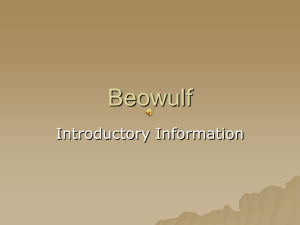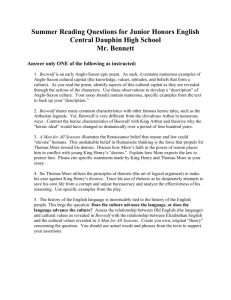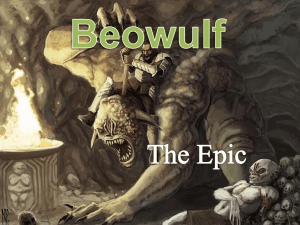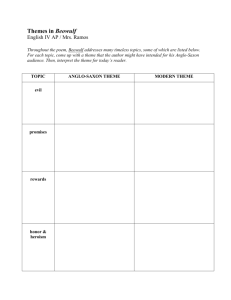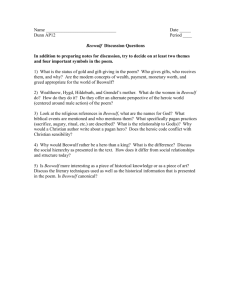幻灯片 1
advertisement
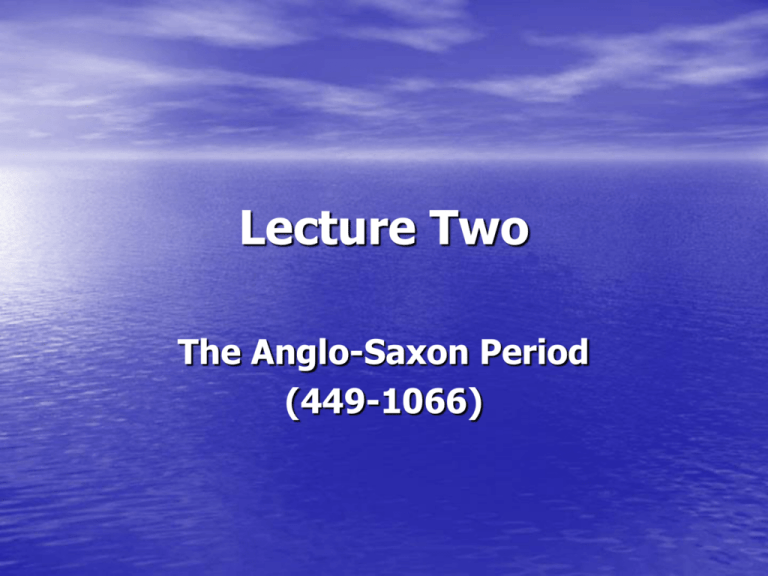
Lecture Two The Anglo-Saxon Period (449-1066) 1. About the history: (1) The early inhabitants on the island we now call England were Britons (a tribe of Celts). From the Britons, the island got its name Britain (the land of Britons). The Britons were a primitive people living in the tribal society. (2) In the middle of the 1st century B.C., Roman troops led by Julius Caesar invaded Britain. Then Britain became a Roman province for nearly 400 years. After the fall of the Roman Empire in 410 A.D., the Roman troops withdrew from Britain. About 449, the Teutonic (n.Teutons ) tribes of Angles, Saxons & Jutes migrated to England from the European Continent, or more specifically, from western Denmark & the northwest coast of Germany. They settled down there & soon ruled over the whole England, enslaving some of the native Celts while driving the others to the hills north & west, to Wales & Scotland & even Ireland across the sea. Thus began the Anglo-Saxon period in English history. (3) The Angles, an important Teutonic tribe, named the new land as Angle-land, afterward shortened into England. The Norman Conquest of England(1066) It was said that king Edward had promised the English throne to William, Duke of Normandy. But after his death, Harold, the richest and most powerful of the English aristocracy, was chosen as king. So William led his army to invade England. In October 1066, during the important battle of Hastings, William defeated Harold and killed him. On one Christmas Day, William was crowned king of England, thus beginning the Norman Conquest of England and marking the end of Anglo-Saxon period. Beowulf • • • • • • • the greatest Old English poem the 7th century 3182 lines the lst English epic Anonymous author translated into modern English The prose form of this poem in modern English consists of 43 sections • The division into sections headed by roman numerals is that of the original manuscript • Epic is an extended narrative poem in elevated or dignified language, like Homer’s Iliad & Odyssey. It usually celebrates the feats of one or more legendary or traditional heroes. The action is simple but full of magnificence. Today, some long narrative works, like novels that reveal an age & its people, are also called epic. The Story Beowulf, the story of the poem, is not about England, but about Hrothgar, the King of the Danes, and about a brave young man, Beowulf, from southern Sweden, who goes to help the King, Hrothgar, who is in trouble. His great hall, called Heorot, is visited at night by a terrible creature, Grendel, which lives in a lake and comes to kill and eat Hrothgar’s men. One night, Beowulf waits secretly for this thing, attacks it, and in a fierce fight pulls its arm off. It manages to reach the lake again, but dies there. Then its mother comes to the hall in search of revenge, and the attacks begin again. Beowulf follows her to the bottom of the lake and kills her there. It is there that he finds the dead body of Grendel. He cuts off the heads of the two monsters and brings the two hairy heads back to the Danish hall. The triumph is celebrated in feasting and song. Then Beowulf goes home and becomes the king and reigns over his people for 50 years. Then he has to defend his country against a fire-breathing creature (fire dragon). He kills the animal but is badly wounded in the fight, and dies. The poem ends with a sorrowful description of Beowulf’s funeral fire. Significance of Beowulf It is the longest & finest of existent old English poems & the national epic of the English people. It sings of the exciting adventures of a great legendary hero whose physical strength demonstrates his high spiritual qualities, i.e. his resolution to serve his country & kinsfolk, his true courage, courteous conduct, and his love of honor. Thematically, this poem shows how the primitive people fight against the forces of the natural world under a wise & mighty leader. Poetic Form and Features of Beowulf Form: Beowulf was written in alliterative verse. Alliteration: the repetition of the initial consonant sounds in poetry. In alliterative verse, certain stressed words in a line begin with the same consonant sound. There are 4 stresses in a line generally, three or two of which show alliteration, as can be seen from the lines from the end of the poem (In modern translation): (see example at PP. 6-7 in Book I Features: • (1) The use of alliteration is one of its most striking features. • (2)The use of compound-words to serve as metaphors: (3) The use of understatements or euphemism The use of understatements gives an impression of reserve(不夸张),and at times, a tinge of ironical humor. This quality is often regarded as a permanent characteristic of English. • (4) It is not a Christian but a pagan poem of all advanced pagan civilization, presenting an all-round picture of the tribal society. So the poem has a great social significance. the main characteristics of AngloSaxon literature Anglo-Saxon literature or the Old English literature is almost exclusively a verse literature in oral form. It could be passed down by word of mouth from generation to generation. It’s creators for the most part are unknown. It was only given a written form long after its composition. There are two groups of English poetry in Anglo—Saxon period. The first group was the pagan poetry represented by Beowulf. It is the oldest poem in the English language and the most important specimen of Anglo-Saxon literature, and also the oldest surviving epic in the English language. The second group was the religious poetry represented by the works of Caedmon & Cynewulf. In the 8th century, Anglo-Saxon prose appeared. The famous prose writers of that period were Venerable Bede & Alfred the Great.
